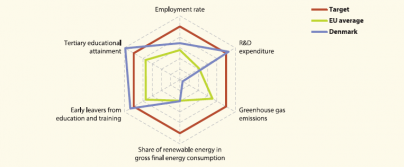Archive:Europe 2020 indicators - Denmark
- Data from July 2013. Most recent data: Further Eurostat information, Main tables.
This article is part of a set of statistical articles based on the Eurostat publication Smarter, greener, more inclusive - Indicators to support the Europe 2020 strategy. It provides recent statistics on the Europe 2020 strategy of the European Union (EU), focusing on the situation in Denmark.

Main statistical findings

In 2012 Denmark exceeded both of its education targets. The percentage of early school leavers from education was 9.1 % and tertiary educational attainment was 3 percentage points above the national target. R&D expenditure (2011 data) was also ahead of the national target and above the EU average rate. The employment rate followed the European trend and fell in the years after the onset of the crisis, leaving the country some distance from its employment target. Despite the favourable developments in the areas of climate change management and renewable energies, further progress similar to or more than the EU average is needed for the country to fulfil its Europe 2020 commitments on reducing GHG emissions and increasing the share of renewable energies. The number of people living in households with very low work intensity deteriorated during the economic crisis, with Denmark among the Member States furthest away from their national poverty targets (2011 data).
Data sources and availability
More information about the origin of the data and the calculation of indicators can be obtained via the Europe 2020 indicators dedicated website.
Under 'Tables', click on the icons next to the indicators:
- 'Explanatory texts (metadata)' for a detailed overview of the collection and compilation methods;
- 'Information on the leaf' for data availability per country.
A more general overview of quality procedures can be found in Implementation of standard reference metadata for indicators - the ESMS Indicator Profile (ESMS-IP).
Context
Measures implemented to meet the national targets
- Employment: Implemented measures aimed at increasing the supply of labour include agreement on a tax reform, a reform of the disability pension scheme and the flexi-job scheme aimed at increasing the supply of labour.
- R&D expenditure: Adoption of specific targets and 27 concrete initiatives under the national innovation strategy “Denmark- a nation of solutions”.
- Renewable energies and climate: Setting up country-specific targets and initiatives for the period 2012-2020 under the Energy Agreement, including an increase in the energy generated from wind turbines, increasing funding for renewable energy technologies, supporting the take-up of renewable energy technologies in buildings, trade and industry; promoting the use of electricity and biomass in the transport sector.
- Early school leaving: Adoption of rules ensuring better inclusion in the primary and lower secondary school; reforms aimed at improving the academic quality of primary and lower secondary education; development programme providing day care for children at a very early age.
- Tertiary education: Reforming vocational education and training programmes, increasing funding for higher education programmes, strengthening education quality through the adoption of a new, comprehensive quality assurance system for higher education.
- Social inclusion: Implementing a number of measures aimed at supporting some of the most disadvantaged groups of society. Some of these initiatives include the abolishment of some low benefits, introducing reforms in the disability pension scheme and the flexi-job scheme.
The European Commission's 2013 country-specific recommendations
- Employment: Further measures, such as education, training and skill upgrading, are needed in order to increase the employability of people with migrant backgrounds, long-term unemployed and low-skilled workers. Addressing the shortages of apprenticeship places and the high drop-out rates in vocational training would be essential in ensuring the future supply of skilled labour.
- Education: Further progress is needed in increasing the quality and cost-effectiveness of education and training systems.
- Others: Implement measures for increasing competition in the service sector, including retail and construction sectors; improve effectiveness in the provision of public services.
See also
Further Eurostat information
Publications
- Smarter, greener, more inclusive - indicators to support the Europe 2020 strategy (online publication, also downloadable as PDF file)
Main tables
Dedicated section
Methodology / Metadata
- Towards robust quality management for European Statistics - Communication from the Commission to the European Parliament and the Council COM(2011) 211 final.
Other information
- Regulation 223/2009 of 11 March 2009 on European statistics